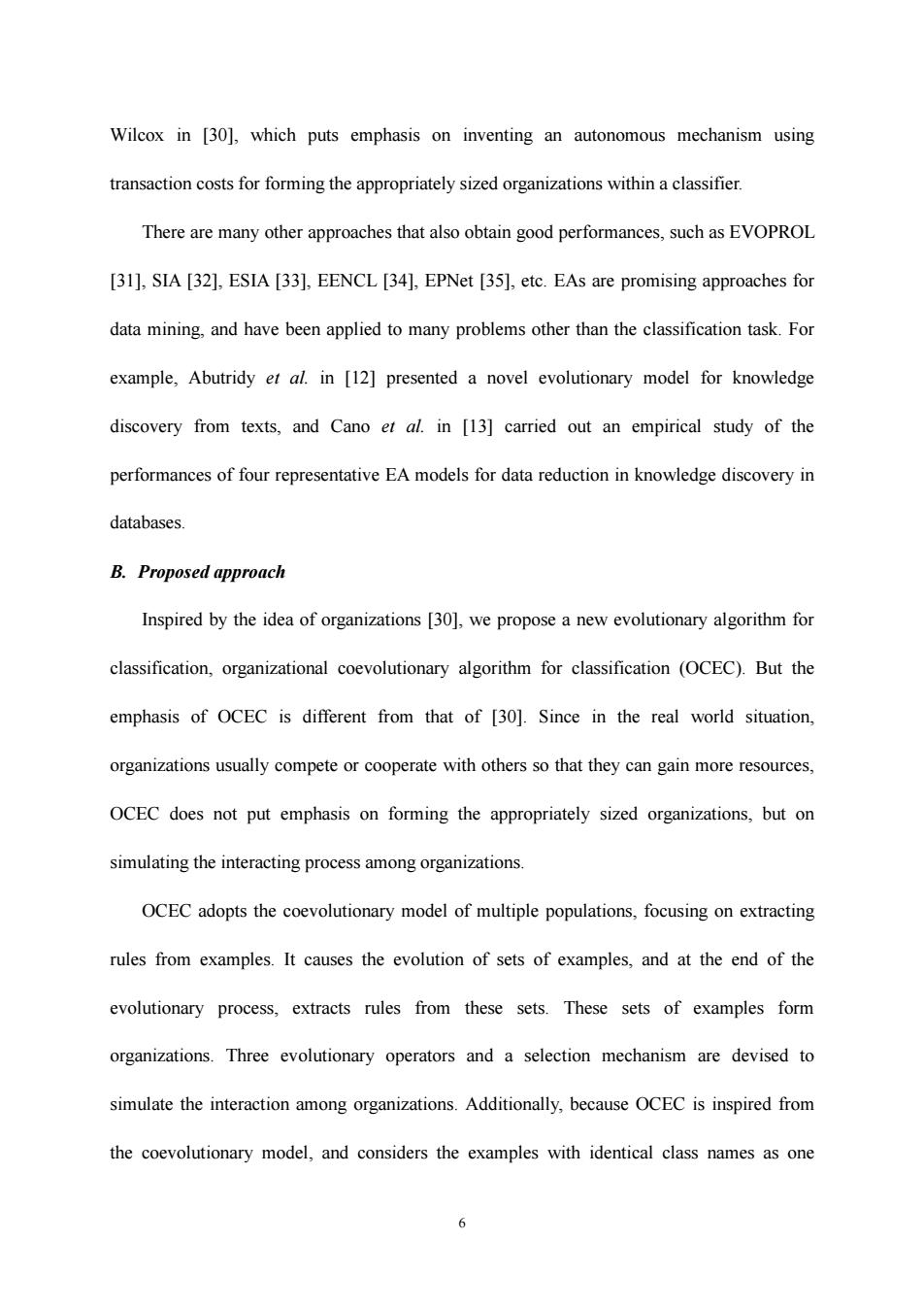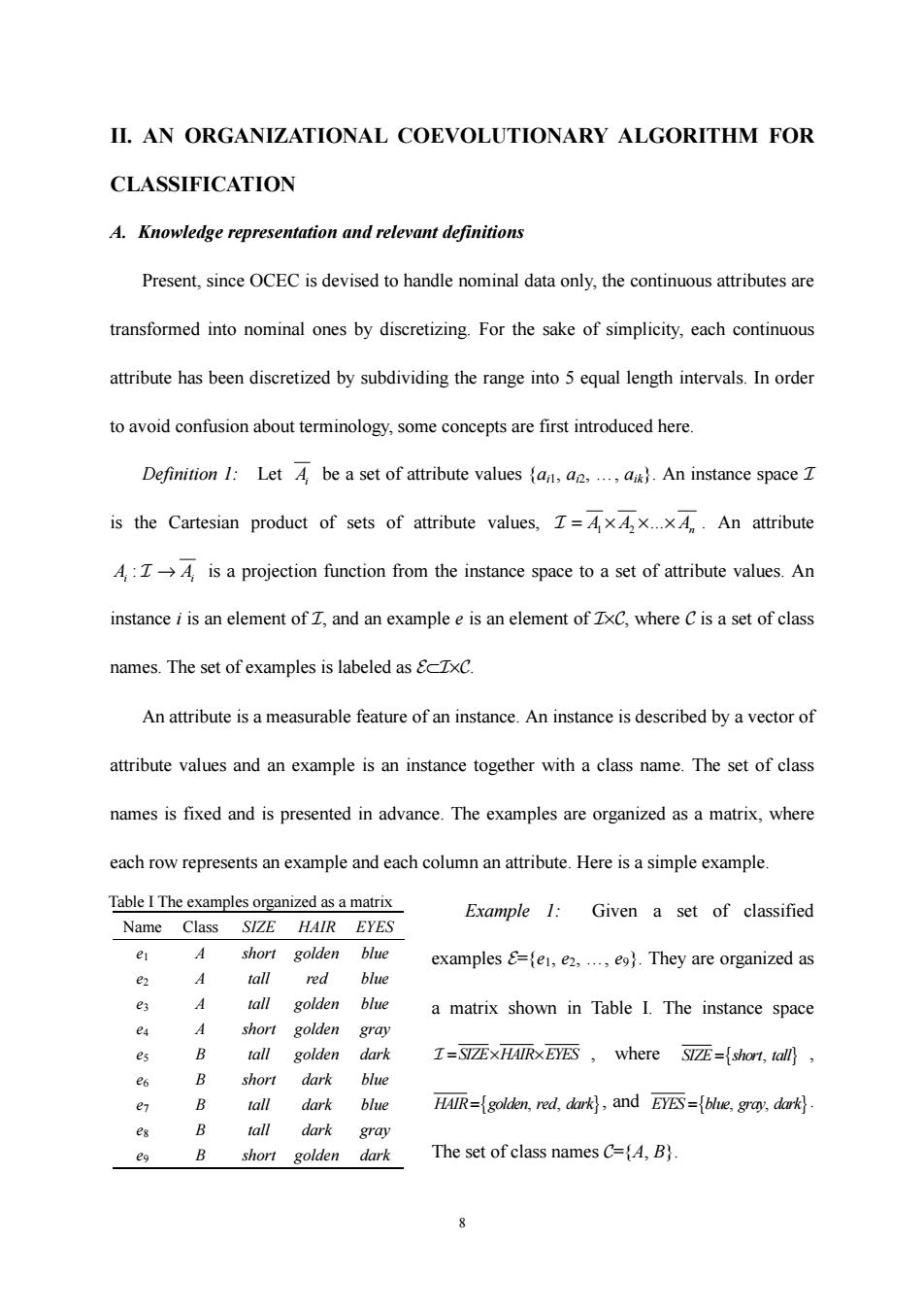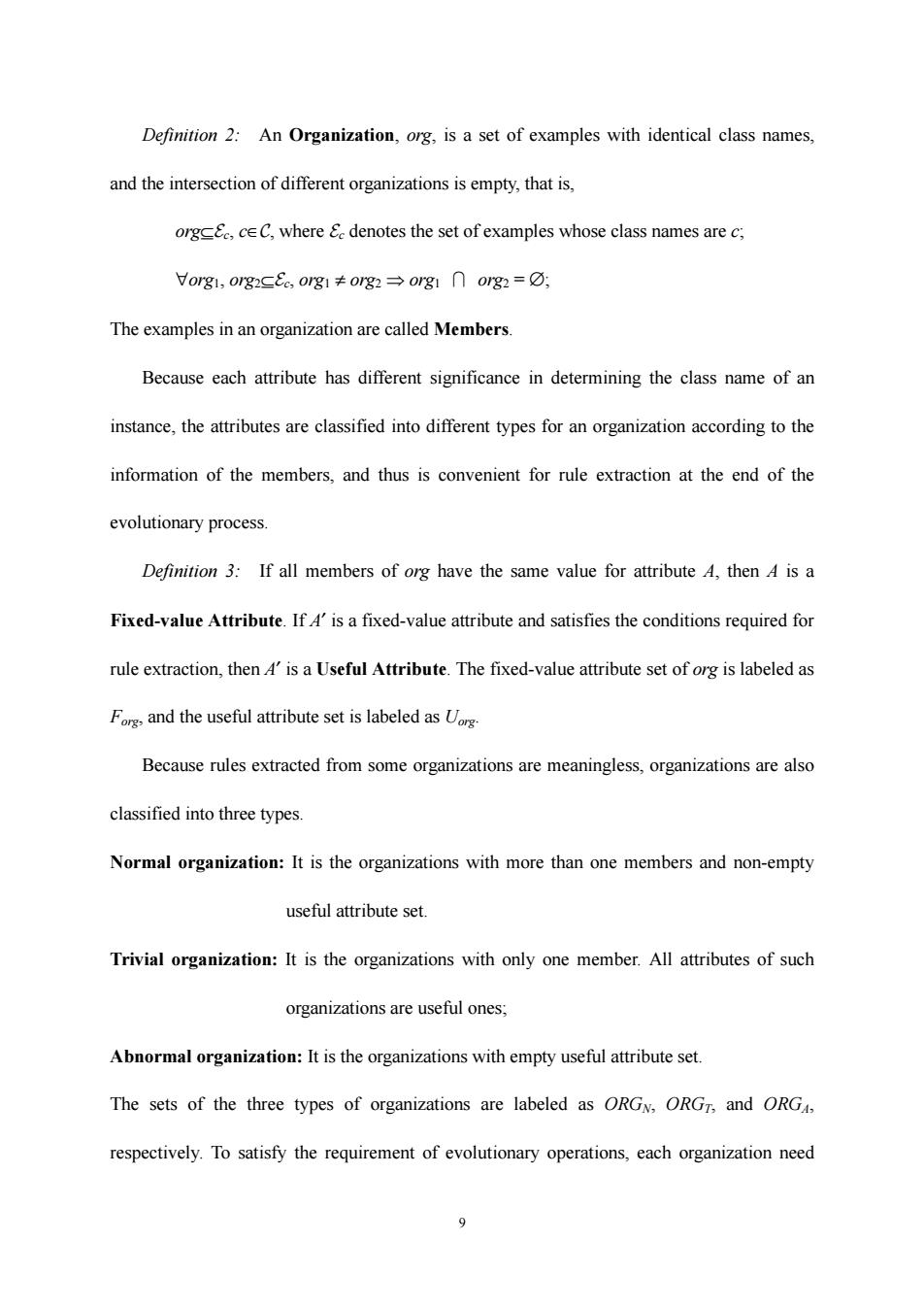
Wilcox in [30],which puts emphasis on inventing an autonomous mechanism using transaction costs for forming the appropriately sized organizations within a classifier. There are many other approaches that also obtain good performances,such as EVOPROL [31],SIA [32],ESIA [33],EENCL [34],EPNet [35],etc.EAs are promising approaches for data mining,and have been applied to many problems other than the classification task.For example,Abutridy et al.in [12]presented a novel evolutionary model for knowledge discovery from texts,and Cano et al.in [13]carried out an empirical study of the performances of four representative EA models for data reduction in knowledge discovery in databases. B.Proposed approach Inspired by the idea of organizations [30],we propose a new evolutionary algorithm for classification,organizational coevolutionary algorithm for classification (OCEC).But the emphasis of OCEC is different from that of [30].Since in the real world situation, organizations usually compete or cooperate with others so that they can gain more resources, OCEC does not put emphasis on forming the appropriately sized organizations,but on simulating the interacting process among organizations. OCEC adopts the coevolutionary model of multiple populations,focusing on extracting rules from examples.It causes the evolution of sets of examples,and at the end of the evolutionary process,extracts rules from these sets.These sets of examples form organizations.Three evolutionary operators and a selection mechanism are devised to simulate the interaction among organizations.Additionally,because OCEC is inspired from the coevolutionary model,and considers the examples with identical class names as one 6
6 Wilcox in [30], which puts emphasis on inventing an autonomous mechanism using transaction costs for forming the appropriately sized organizations within a classifier. There are many other approaches that also obtain good performances, such as EVOPROL [31], SIA [32], ESIA [33], EENCL [34], EPNet [35], etc. EAs are promising approaches for data mining, and have been applied to many problems other than the classification task. For example, Abutridy et al. in [12] presented a novel evolutionary model for knowledge discovery from texts, and Cano et al. in [13] carried out an empirical study of the performances of four representative EA models for data reduction in knowledge discovery in databases. B. Proposed approach Inspired by the idea of organizations [30], we propose a new evolutionary algorithm for classification, organizational coevolutionary algorithm for classification (OCEC). But the emphasis of OCEC is different from that of [30]. Since in the real world situation, organizations usually compete or cooperate with others so that they can gain more resources, OCEC does not put emphasis on forming the appropriately sized organizations, but on simulating the interacting process among organizations. OCEC adopts the coevolutionary model of multiple populations, focusing on extracting rules from examples. It causes the evolution of sets of examples, and at the end of the evolutionary process, extracts rules from these sets. These sets of examples form organizations. Three evolutionary operators and a selection mechanism are devised to simulate the interaction among organizations. Additionally, because OCEC is inspired from the coevolutionary model, and considers the examples with identical class names as one

population,it can handle multi-class learning in a natural way so that multiple classes can be learned simultaneously. The main process of the existing EA-based and stochastic search classification algorithms [36],is first generating rules randomly,and then improving the quality of the rules by using the training examples.So these algorithms adopt an up-bottom search mechanism,and may generate meaningless rules during the evolutionary process.But OCEC adopts a completely different search mechanism.For classification,if the obtained description is represented as rules,then each rule covers some examples,and the examples covered by the same rule have some similarities in attribute values.Based on this,OCEC first clusters the examples with similar attribute values so as to form organizations,and then guides the evolutionary process by using the differing significance of attributes.At the end of the evolutionary process,rules are extracted from organizations.Such a process can avoid generating meaningless rules. Therefore,OCEC adopts a bottom-up search mechanism. C.Organization ofpaper In the remainder of this paper,OCEC is described in Section II.Section III evaluates the effectiveness of OCEC by multiplexer problems.Section IV compares OCEC with the available algorithms on benchmarks,and applies OCEC to a practical case,the radar target recognition problem.The scalability of OCEC is studied in Section V.Finally,conclusions and some ideas for the future work are presented in the last section. >
7 population, it can handle multi-class learning in a natural way so that multiple classes can be learned simultaneously. The main process of the existing EA-based and stochastic search classification algorithms [36], is first generating rules randomly, and then improving the quality of the rules by using the training examples. So these algorithms adopt an up-bottom search mechanism, and may generate meaningless rules during the evolutionary process. But OCEC adopts a completely different search mechanism. For classification, if the obtained description is represented as rules, then each rule covers some examples, and the examples covered by the same rule have some similarities in attribute values. Based on this, OCEC first clusters the examples with similar attribute values so as to form organizations, and then guides the evolutionary process by using the differing significance of attributes. At the end of the evolutionary process, rules are extracted from organizations. Such a process can avoid generating meaningless rules. Therefore, OCEC adopts a bottom-up search mechanism. C. Organization of paper In the remainder of this paper, OCEC is described in Section II. Section III evaluates the effectiveness of OCEC by multiplexer problems. Section IV compares OCEC with the available algorithms on benchmarks, and applies OCEC to a practical case, the radar target recognition problem. The scalability of OCEC is studied in Section V. Finally, conclusions and some ideas for the future work are presented in the last section

II.AN ORGANIZATIONAL COEVOLUTIONARY ALGORITHM FOR CLASSIFICATION A.Knowledge representation and relevant definitions Present,since OCEC is devised to handle nominal data only,the continuous attributes are transformed into nominal ones by discretizing.For the sake of simplicity,each continuous attribute has been discretized by subdividing the range into 5 equal length intervals.In order to avoid confusion about terminology,some concepts are first introduced here. Definition I:Let 4 be a set of attribute values (an,a,...,a).An instance space I is the Cartesian product of sets of attribute values,Z=Ax4x...xA..An attribute 4:Z->4,is a projection function from the instance space to a set of attribute values.An instance i is an element of Z,and an example e is an element of ZxC,where C is a set of class names.The set of examples is labeled as EcZxC. An attribute is a measurable feature of an instance.An instance is described by a vector of attribute values and an example is an instance together with a class name.The set of class names is fixed and is presented in advance.The examples are organized as a matrix,where each row represents an example and each column an attribute.Here is a simple example. Table I The examples organized as a matrix Example 1:Given a set of classified Name Class SIZE HAIR EYES 9 1 short golden blue examples =e1,e2,...,e9).They are organized as e2 A tall red blue e3 y tall golden blue a matrix shown in Table I.The instance space g short golden gray es B tall golden dark I=SIZEXHAIRXEYES where SIZE={short,tall 及 short dark blue S B tall dark blue HAIR=golden,red,dark,and EYES=blue,gray,dark tall dark gray B short golden dark The set of class names C=(A,B). 8
8 II. AN ORGANIZATIONAL COEVOLUTIONARY ALGORITHM FOR CLASSIFICATION A. Knowledge representation and relevant definitions Present, since OCEC is devised to handle nominal data only, the continuous attributes are transformed into nominal ones by discretizing. For the sake of simplicity, each continuous attribute has been discretized by subdividing the range into 5 equal length intervals. In order to avoid confusion about terminology, some concepts are first introduced here. Definition 1: Let Ai be a set of attribute values {ai1, ai2, …, aik}. An instance space I is the Cartesian product of sets of attribute values, 1 2 ... I = × ×× AA An . An attribute : A A i i I → is a projection function from the instance space to a set of attribute values. An instance i is an element of I, and an example e is an element of I×C, where C is a set of class names. The set of examples is labeled as E⊂I×C. An attribute is a measurable feature of an instance. An instance is described by a vector of attribute values and an example is an instance together with a class name. The set of class names is fixed and is presented in advance. The examples are organized as a matrix, where each row represents an example and each column an attribute. Here is a simple example. Example 1: Given a set of classified examples E={e1, e2, …, e9}. They are organized as a matrix shown in Table I. The instance space I =× × SIZE HAIR EYES , where SIZE short tall ={ , } , HAIR golden red dark ={ , , } , and EYES blue gray dark ={ , , } . The set of class names C={A, B}. Table I The examples organized as a matrix Name Class SIZE HAIR EYES e1 A short golden blue e2 A tall red blue e3 A tall golden blue e4 A short golden gray e5 B tall golden dark e6 B short dark blue e7 B tall dark blue e8 B tall dark gray e9 B short golden dark

Definition 2:An Organization,org,is a set of examples with identical class names, and the intersection of different organizations is empty,that is, orgcEc,ceC,where &c denotes the set of examples whose class names are c; Vorg1,o1g2CE。,org1≠org2→0rg1∩0rg2=☑: The examples in an organization are called Members. Because each attribute has different significance in determining the class name of an instance,the attributes are classified into different types for an organization according to the information of the members,and thus is convenient for rule extraction at the end of the evolutionary process. Definition 3:If all members of org have the same value for attribute A,then A is a Fixed-value Attribute.If 4'is a fixed-value attribute and satisfies the conditions required for rule extraction,then 4'is a Useful Attribute.The fixed-value attribute set of org is labeled as Fand the useful attribute set is labeled as Because rules extracted from some organizations are meaningless,organizations are also classified into three types. Normal organization:It is the organizations with more than one members and non-empty useful attribute set. Trivial organization:It is the organizations with only one member.All attributes of such organizations are useful ones; Abnormal organization:It is the organizations with empty useful attribute set. The sets of the three types of organizations are labeled as ORGN,ORGT,and ORG, respectively.To satisfy the requirement of evolutionary operations,each organization need 9
9 Definition 2: An Organization, org, is a set of examples with identical class names, and the intersection of different organizations is empty, that is, org⊆Ec, c∈C, where Ec denotes the set of examples whose class names are c; ∀org1, org2⊆Ec, org1 ≠ org2 ⇒ org1 ∩ org2 = ∅; The examples in an organization are called Members. Because each attribute has different significance in determining the class name of an instance, the attributes are classified into different types for an organization according to the information of the members, and thus is convenient for rule extraction at the end of the evolutionary process. Definition 3: If all members of org have the same value for attribute A, then A is a Fixed-value Attribute. If A′ is a fixed-value attribute and satisfies the conditions required for rule extraction, then A′ is a Useful Attribute. The fixed-value attribute set of org is labeled as Forg, and the useful attribute set is labeled as Uorg. Because rules extracted from some organizations are meaningless, organizations are also classified into three types. Normal organization: It is the organizations with more than one members and non-empty useful attribute set. Trivial organization: It is the organizations with only one member. All attributes of such organizations are useful ones; Abnormal organization: It is the organizations with empty useful attribute set. The sets of the three types of organizations are labeled as ORGN, ORGT, and ORGA, respectively. To satisfy the requirement of evolutionary operations, each organization need

record some information.Therefore,an organization is represented as the following structure, Organization Record Member List:Record the name of each member in this organization; Attribute Type:Record the type of each attribute in this organization,that is,fixed-value attribute,useful attribute, or others; Organization Type:Record the type of this organization,that is,trivial organization,abnormal organization,or normal organization; Member class:Record the class name of all members; Fitness:Record the fitness of this organization; End. B.Fitness function for organizations After analyzing the relation between attributes and examples,we think that there are two factors to be considered in devising the fitness function for organizations, (1)The number of members:The more members an organization has,the better the quality of the rule extracted from it.Therefore,the fitness of an organization should increase with the number of members. (2)The number of useful attributes:Useful attributes will be used to generate rules at the end of the evolutionary process.The more useful attributes are,the more conditions the rules have.In fact,the more conditions a rule has,the fewer examples the rule covers.But over-generalization will result if the conditions are too few.Therefore,the fitness of an 10
10 record some information. Therefore, an organization is represented as the following structure, Organization = Record Member_List: Record the name of each member in this organization; Attribute_Type: Record the type of each attribute in this organization, that is, fixed-value attribute, useful attribute, or others; Organization_Type: Record the type of this organization, that is, trivial organization, abnormal organization, or normal organization; Member_Class: Record the class name of all members; Fitness: Record the fitness of this organization; End. B. Fitness function for organizations After analyzing the relation between attributes and examples, we think that there are two factors to be considered in devising the fitness function for organizations, (1) The number of members: The more members an organization has, the better the quality of the rule extracted from it. Therefore, the fitness of an organization should increase with the number of members. (2) The number of useful attributes: Useful attributes will be used to generate rules at the end of the evolutionary process. The more useful attributes are, the more conditions the rules have. In fact, the more conditions a rule has, the fewer examples the rule covers. But over-generalization will result if the conditions are too few. Therefore, the fitness of an